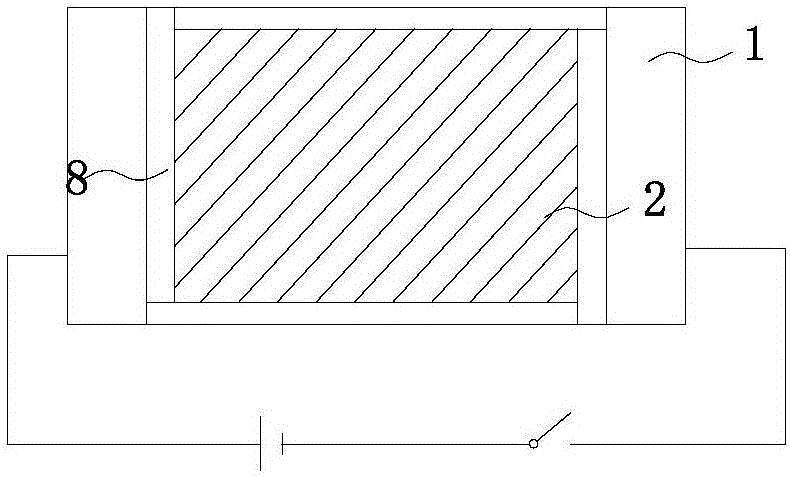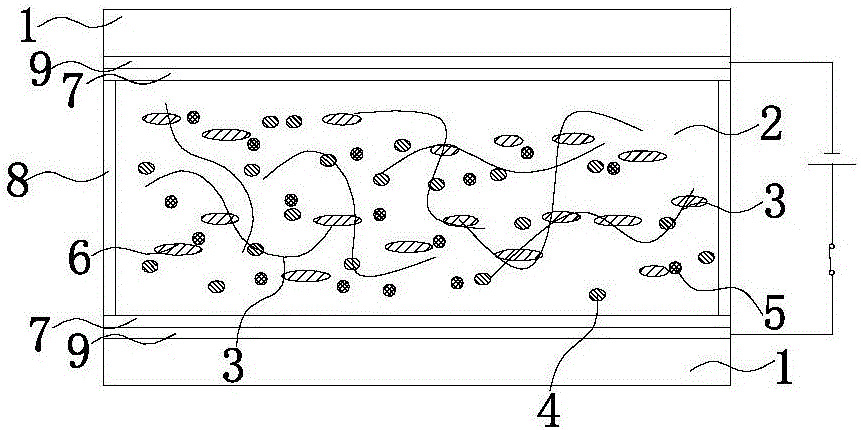Switchable glass based on subtractive color mixing method
A technology of dimming glass and hybrid method, which is applied in the fields of optics, nonlinear optics, chemical instruments and methods, etc., can solve the problems that reflective materials are easy to interfere with navigation and communication systems, and are not conducive to the popularization and wide application of coated glass windows.
- Summary
- Abstract
- Description
- Claims
- Application Information
AI Technical Summary
Problems solved by technology
Method used
Image
Examples
Embodiment 1
[0026] The following steps are used to prepare the dimming glass based on the subtractive color mixing method: 1) Prepare two light-transmitting substrates, both of which include a substrate and a transparent electrode arranged on the surface of the substrate, and the two light-transmitting substrates are opposed to each other. A vertical alignment layer is coated on the surface, and a encapsulating plastic frame is used to encapsulate the two light-transmitting substrates to form a liquid crystal cell, and the adjustment area is provided with spacers for controlling the distance between the two light-transmitting substrates; 2) Preparation of mixed liquid crystal: under yellow light conditions, weigh 91-95.8 parts by mass of negative liquid crystal, 3-5 parts by mass of photopolymerizable liquid crystal monomer, 0.5-1 parts by mass of photoinitiator and 0.5 -1 parts by mass of the dichroic dye RL002, 0.1-1 parts by mass of the red common dye R20, and 0.1-1 parts by mass of the ...
Embodiment 2
[0032] This embodiment is basically the same as embodiment 1, but the difference is that the mixed liquid crystal is prepared under yellow light conditions by combining negative liquid crystal, photopolymerizable liquid crystal monomer, photoinitiator and dichroic dye RL013, blue The color common dye C1 and the yellow common dye Y9 are weighed into a brown reagent bottle according to the mass ratio of 94.05:3:0.5:1:0.65:0.8, and then mixed evenly to obtain a mixed liquid crystal. The liquid crystal cell prepared by the dichroic dye RL013 and the blue common dye C1 and the yellow common dye Y9 used in this example shows almost colorless and transparent state when no voltage is applied; when voltage is applied, it shows a light purple fuzzy state .
Embodiment 3
[0034] This embodiment is basically the same as embodiment 1, but the difference is that the mixed liquid crystal is prepared under the condition of yellow light by combining negative liquid crystal, photopolymerizable liquid crystal monomer, photoinitiator and dichroic dye RL014, red Common dye R20 and yellow common dye Y9 are weighed into a brown reagent bottle according to the mass ratio of 91:5:1:1:0.3:0.4, and then mixed uniformly to obtain a mixed liquid crystal. The liquid crystal cell prepared by the dichroic dye RL014, the red common dye R20, and the yellow common dye Y9 used in this embodiment shows almost a colorless and transparent state when no voltage is applied; when a voltage is applied, it shows a black fuzzy state.
PUM
 Login to View More
Login to View More Abstract
Description
Claims
Application Information
 Login to View More
Login to View More - R&D
- Intellectual Property
- Life Sciences
- Materials
- Tech Scout
- Unparalleled Data Quality
- Higher Quality Content
- 60% Fewer Hallucinations
Browse by: Latest US Patents, China's latest patents, Technical Efficacy Thesaurus, Application Domain, Technology Topic, Popular Technical Reports.
© 2025 PatSnap. All rights reserved.Legal|Privacy policy|Modern Slavery Act Transparency Statement|Sitemap|About US| Contact US: help@patsnap.com



